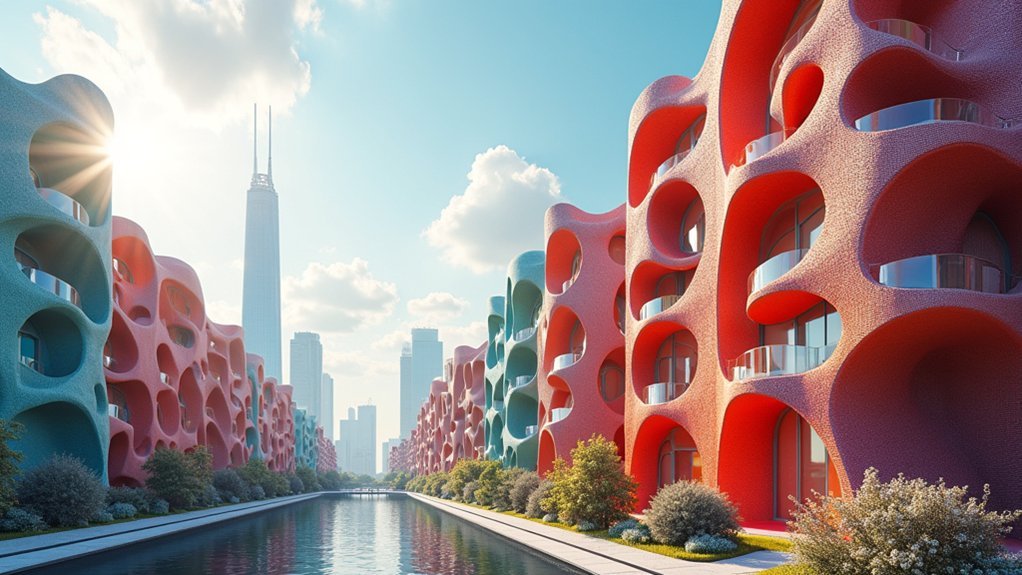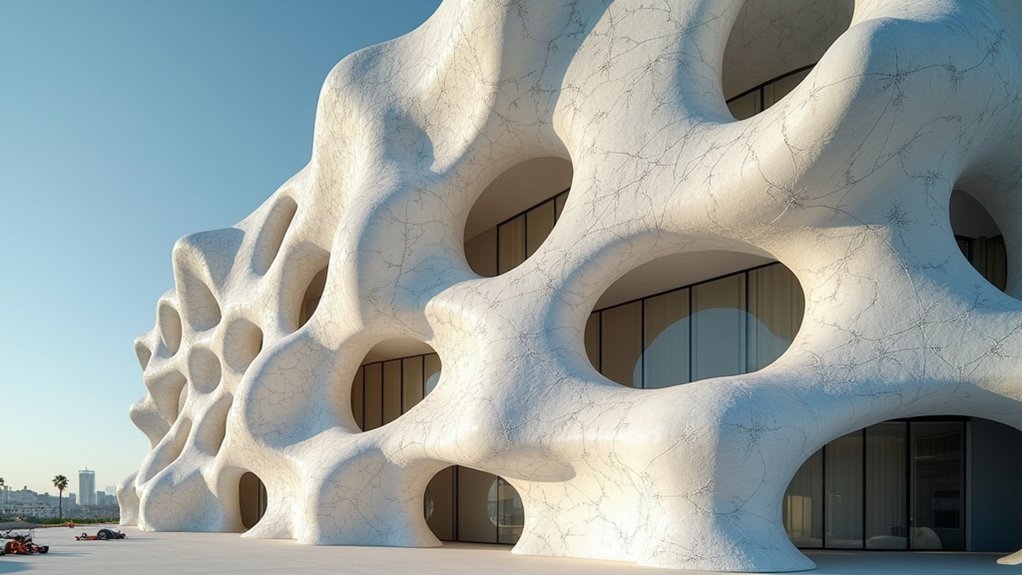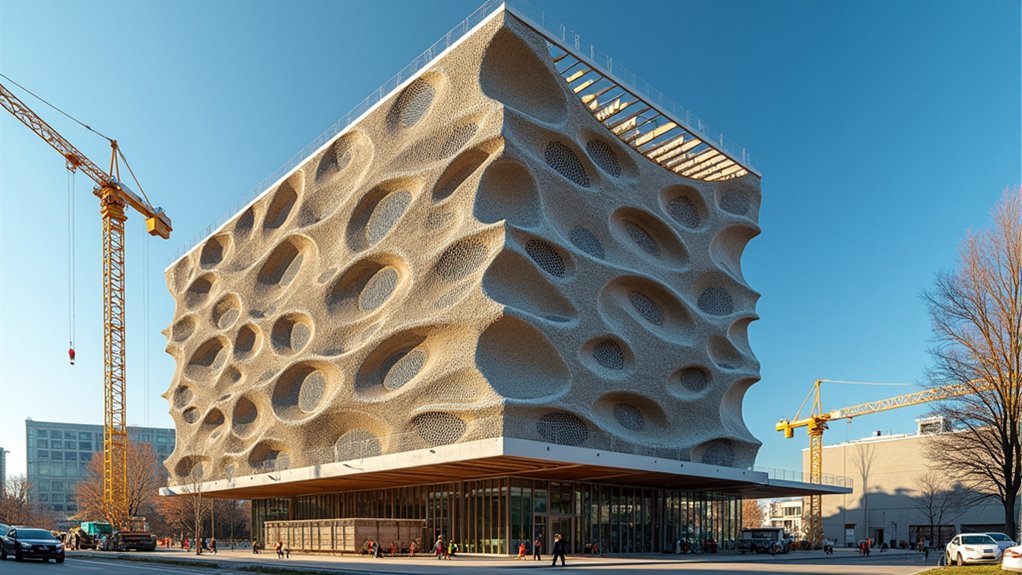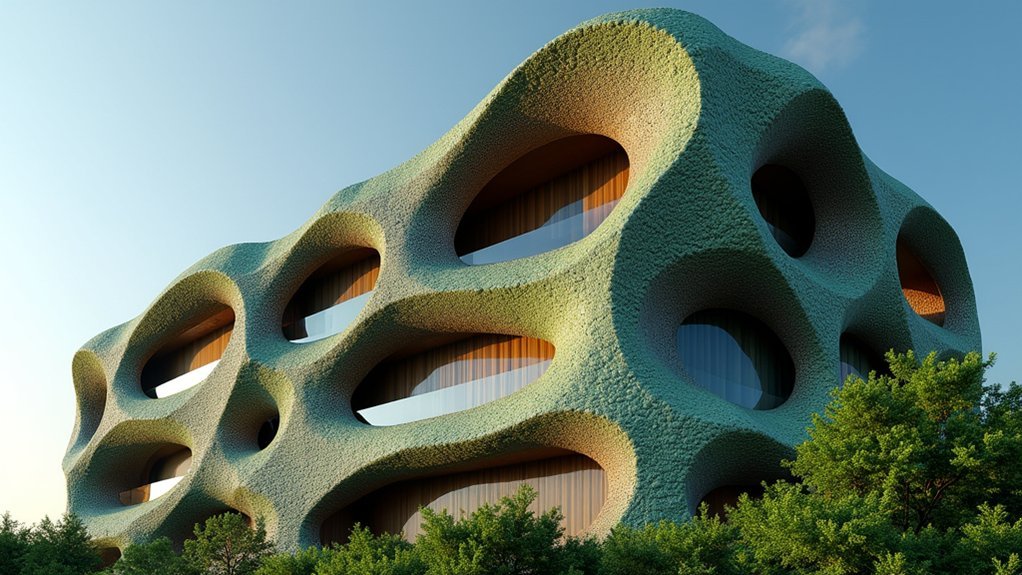You’re witnessing a fundamental shift in architecture as 3D printing technology transforms traditional building facades into customizable, sustainable structures that can be manufactured with 90% less material waste than conventional methods. This revolutionary approach uses recycled materials and bio-based composites to create complex geometries previously impossible with traditional construction. You’ll benefit from reduced labor costs, automated processes, and enhanced energy efficiency through integrated solar shading systems. Discover how this technology’s also preserving historical architecture while overcoming current implementation challenges.
Advanced 3D Printing Technologies Transforming Facade Design

While traditional construction methods have long constrained architects to geometric limitations, advanced 3D printing technologies are now releasing unprecedented creative freedom in facade design.
3D printing technology breaks through architectural boundaries, empowering designers to create complex facade geometries previously impossible with conventional construction methods.
You’ll discover that these innovations enable complex customizable structures through techniques like powder bonding and extrusion, creating unique textures and enhanced performance properties.
The layer-by-layer construction process you’ll encounter minimizes material waste considerably, promoting sustainability by using only necessary materials for each component.
You can now optimize energy efficiency by incorporating solar shading and ventilation systems directly into facades.
Projects utilizing recycled materials demonstrate how innovative designs combine environmental responsibility with architectural creativity, reducing overall environmental impact while achieving previously impossible geometries that transform building aesthetics and functionality.
Material Innovation and Sustainable Facade Solutions
As 3D printing technology advances, you’ll find that material innovations are driving a fundamental shift toward sustainable facade solutions that outperform traditional building materials.
You can now utilize recycled plastics and bio-based composites that dramatically reduce environmental impact while maintaining exceptional aesthetic appeal. The layer-by-layer construction process minimizes material waste by up to 90%, making these innovative solutions remarkably efficient.
Key advantages of sustainable 3D-printed facade materials include:
- Enhanced durability – Advanced composites withstand environmental stressors with minimal maintenance requirements
- Energy efficiency optimization – Integrated ventilation and shading elements reduce building energy consumption
- Customizable design flexibility – Complex patterns and intricate geometries achieve superior architectural aesthetics
These durable materials enable you to create facades that combine environmental responsibility with cutting-edge design capabilities, revolutionizing how you approach building construction.
Cost-Effective Complex Architectural Elements Through Digital Fabrication

Digital fabrication transforms your ability to create sophisticated architectural elements that previously demanded prohibitive costs and extensive manufacturing timelines.
Through 3D printing, you’ll produce complex designs with intricate facades that traditional methods can’t economically achieve. You’ll greatly lower labor costs by utilizing automated processes that minimize skilled labor requirements while maintaining precision.
3D printing delivers intricate architectural facades at economical costs while reducing labor requirements through automated precision manufacturing processes.
Digital fabrication enables you to manufacture customized components on demand, helping you reduce waste by using only necessary materials for sustainable construction.
You’ll leverage rapid prototyping to iterate designs quickly, testing and refining elements before final production. With innovative materials like recycled plastics and bio-based composites, you’ll enhance both aesthetic and functional properties of architectural elements while maintaining cost-effectiveness throughout your projects.
Preserving Historical Architecture With Modern 3D Reconstruction Methods
When historical buildings suffer damage from natural disasters or conflict, you’ll find that 3D printing technology offers unprecedented opportunities to restore intricate architectural details with remarkable precision.
This modern technology revolutionizes architectural restoration by creating intricate replicas of damaged ornamental elements while preserving the essence of traditional craftsmanship.
You can now access restoration solutions that were previously impossible or prohibitively expensive:
- Digital catalog creation through laser scanning software enables architects to store and reproduce historical architecture components on demand
- Rapid production capabilities allow firms like New York’s EDG to complete restoration projects using plastic molds within a single day
- Cost-effective reconstruction considerably reduces expenses compared to traditional restoration methods
The efficiency of 3D printing transforms cultural preservation, ensuring historical treasures survive for future generations through seamless integration of innovation and heritage.
Overcoming Technical Challenges in Large-Scale Facade Implementation

While 3D printing excels at recreating intricate historical details, scaling this technology for entire building facades presents formidable obstacles that you’ll need to navigate carefully.
Overcoming technical limitations requires developing materials that meet conventional construction standards while maintaining structural integrity. You’ll face regulatory hurdles since existing building codes don’t accommodate 3D printing methods, complicating your approval processes for large-scale facade implementation.
Current printing speeds of 3.5 meters per hour remain slower than traditional methods, demanding production innovations. You’ll need specialized expertise beyond traditional construction skills to design complex facade structures effectively.
Additionally, establishing standardized testing protocols for 3D printed materials becomes critical for gaining regulatory approval and ensuring your building facades withstand various environmental conditions reliably.
Frequently Asked Questions
How Long Does Regulatory Approval Typically Take for 3D Printed Facades?
You’ll typically wait 6-18 months for regulatory approval of 3D printed facades. The timeline depends on your local building codes, structural complexity, and whether you’re using previously approved materials and printing methods.
What Maintenance Requirements Do 3D Printed Building Facades Have Over Time?
You’ll need periodic cleaning, surface inspections for cracks or wear, and potential resealing depending on materials used. Most 3D printed facades require less maintenance than traditional systems due to fewer joints and seamless construction methods.
Can Existing Buildings Be Retrofitted With 3D Printed Facade Elements?
You can retrofit existing buildings with 3D printed facade elements by designing custom panels that attach to current structural systems. You’ll need engineering assessments to guarantee proper load distribution and secure mounting methods.
What Weather Conditions Affect the Installation of 3D Printed Facades?
You’ll face challenges during extreme temperatures, high winds, and precipitation. Rain damages uncured materials, while freezing temperatures affect bonding. You should avoid installation during storms, as wind destabilizes large panels during mounting.
How Do Insurance Policies Cover Buildings With 3D Printed Facades?
You’ll find most insurance policies don’t specifically address 3D printed facades yet. You’ll need to work with insurers to evaluate materials, structural integrity, and fire resistance. You should expect higher premiums until industry standards develop.





Leave a Reply